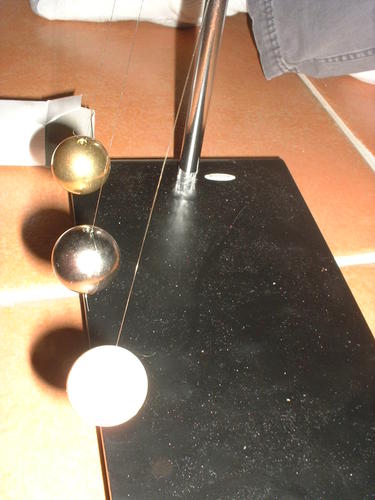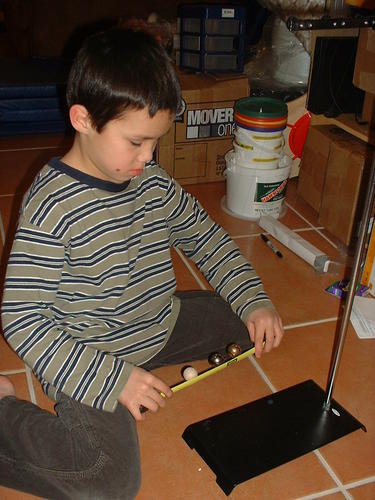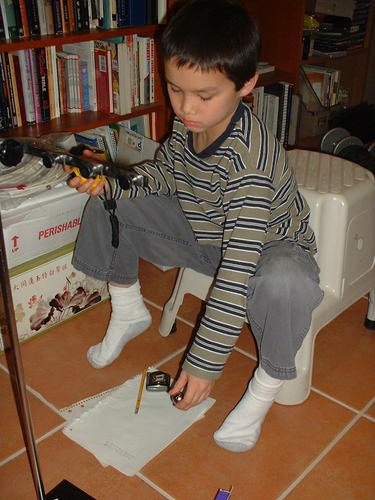
For his science fair project, Jonathan investigated pendulums. His hypothesis was that how fast the pendulum swings, its period, should depend on how heavy it was. So I arranged to have 1-inch diameter pendulum bobs made of copper, steel, and wood. We suspended each from a horizontal beam, carefully measured so they were all the same length, then swung them back in synch.

If was pretty clear that they all were swinging together and staying together. Not perfectly, but pretty close. Since the weight difference between the copper and wood is pretty large, he was surprised.
We repeated the experiment several times with the same results. Except for once. One of the strings wasn’t tied so well, and after repeated swinging, it slipped by about an inch or two. After it slipped, it began to swing slower. That motivated Jonathan to try another experiment: let’s vary the length of the string and see how that changes things.

So, armed with a tape measure and a stop watch, we measured off lengths from 3 inches all the way to 24 inches for the pendulum. Jonathan’s reflexes are pretty good, but it’s hard to be more accurate than about 1/4 second (actually, there have been some tests that show that with practice and coordination, you can get that down to about 1/10 second, but that’s not us!).

We also included our measurements that we did first, with the length at 14 inches to come up with the following values.
|
Length |
10xPeriod (seconds) |
| 3 | 5.47 |
| 6 | 8.38 |
| 9 | 10.12 |
| 12 | 11.53 |
| 14 | 12.69 |
| 15 | 12.78 |
| 18 | 13.62 |
| 21 | 14.84 |
| 23 | 15.44 |
| 24 | 16.81 |
When we plot the data, we get the graph shown below. I’ve put error bars of 0.35 seconds assuming a 0.25 second uncertainty (due to reaction time) on both ends of the swing. We let the pendulum swing back and forth 10 times to make it easier to measure and amortize the reaction time error over more periods. Trying to accurately measure the half-second period of a 3-inch pendulum would have been very difficult, but measuring the 5-second time for 10 periods was (relatively) easy.
The graph has shifted all of the lengths by 1/2 inch. Our measurements were the length of the string, but the correct length for a pendulum is the from the beam to the center of mass, which is effectively the center of the bob (we used 10-pound nylon fishing line).

The blue dotted straight line is there only to show that the data do not fall on a straight line. It’s not completely obvious that this is not true, which is why extending the data to longer and shorter lengths would have been good. Oh well. It’s still a good experiment and good work by Jonathan.
Written by Roland Roberts
Search
.Archives
- October 2024 (1)
- May 2024 (2)
- April 2024 (3)
- September 2022 (5)
- April 2022 (1)
- January 2022 (3)
- December 2021 (4)
- September 2021 (3)
- July 2021 (1)
- January 2021 (1)
- November 2020 (2)
- October 2020 (2)
- September 2020 (2)
- August 2020 (5)
- July 2020 (1)
- November 2019 (2)
- September 2019 (1)
- August 2019 (2)
- September 2017 (1)
- August 2017 (1)
- September 2015 (3)
- August 2015 (2)
- June 2015 (5)
- May 2015 (3)
- May 2013 (2)
- January 2013 (1)
- December 2012 (2)
- September 2012 (1)
- June 2012 (1)
- May 2012 (1)
- October 2011 (2)
- September 2011 (2)
- April 2011 (2)
- March 2011 (10)
- January 2011 (8)
- November 2010 (2)
- October 2010 (1)
- September 2010 (3)
- August 2010 (2)
- July 2010 (1)
- June 2010 (1)
- April 2010 (3)
- February 2010 (3)
- January 2010 (3)
- December 2009 (6)
- November 2009 (3)
- October 2009 (7)
- September 2009 (8)
- August 2009 (4)
- July 2009 (1)
- June 2009 (2)
- May 2009 (2)
- April 2009 (7)
- March 2009 (1)
- February 2009 (6)
- January 2009 (4)
- December 2008 (4)
- November 2008 (3)
- October 2008 (11)
- September 2008 (4)
- August 2008 (5)
- July 2008 (5)
- June 2008 (2)
- April 2008 (4)
- March 2008 (18)
- February 2008 (9)
- November 2007 (1)
- October 2007 (3)
- July 2007 (3)
- April 2007 (1)
- March 2007 (6)
- February 2007 (3)
- December 2006 (3)
- October 2006 (4)
- September 2006 (1)
- July 2006 (5)
- May 2006 (10)
- April 2006 (9)
